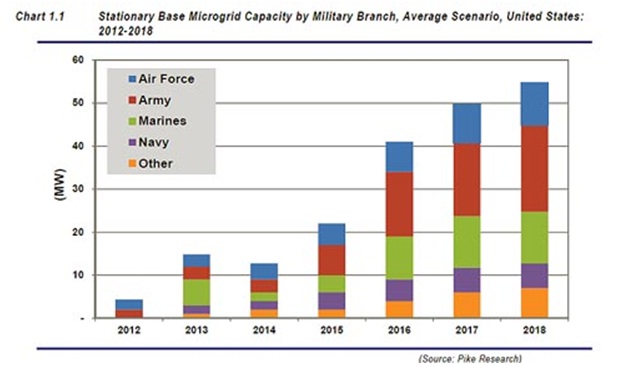Aside from the use of drones, one of the most innovative and effective ways of protecting the lives of America’s uniformed troops may be microgrids—the distributed generation of forms of renewable energy that do not have to be transported under high security to every battle zone.
To date, U.S. military operations in Afghanistan have paid the equivalent of $400 per gallon for fossil fuel when security, transportation, and mortality costs are tallied up. Indeed, according to the findings of a new research report, the United States Department of Defense (DOD) is the single largest consumer of petroleum in the world. Likewise, U.S. military operations represent the largest consumer of all forms of energy globally.
The study, “Military Microgrids,” by Boulder, Colorado-based Pike Research (News - Alert) suggests that efforts by the U.S. DOD may provide the strongest momentum overall to the microgrid market today. Pike Research forecasts that, in a typical war-time scenario, the total capacity of U.S. military microgrids will reach 54.8 megawatts by 2018.Microgrids can shrink the amount of fossil fuels consumed to create electricity by networking generators as a system to maximize efficiency. They also can be used to help integrate renewable energy resources (such as wind and solar) at the local distribution grid level. Simultaneously, microgrids enable military bases – both stationary and forward operating bases (FOBs) – to sustain operations, no matter what is happening on the larger utility grid or in the theater of war.

The military’s primary concern is disruptions of service from utility transmission and distribution (T&D) lines. Its lack of control and ownership of these lines – and the uneven quality of power service regionally throughout the United States – has prompted the U.S. DOD to reexamine the existing electricity service delivery model. This analysis has led the DOD to the inevitable conclusion that the best way to bolster its ability to secure power may well be through microgrid technology it can often own and control. Furthermore, recent mandates require an increase in the reliance upon renewable energy developed onsite, whether the generation is solar PV or waste-to-energy combustion. A microgrid can tie these disparate and distributed resources together and allow them to be managed locally.
Likewise, for fixed base military operations, microgrids offer the ultimate secure power supply. Many Army, Navy, Air Force, Marines, and other military-related bases and offices already have vintage microgrids in place. What is new is that these facilities are looking to envelop entire bases with microgrids and integrate renewable distributed energy generation (RDEG) onsite. When capable of safe islanding from the surrounding grid, RDEG offers ultimate security since fuel never runs out with solar or wind resources.
Pike Research has identified roughly two dozen military facilities in the United States that are currently engaged in smart microgrid implementations. The Marines show the fastest initial capacity growth spurt, but the Army shows signs of longer-term increases in annual capacity. This is because the Army has a larger number of stationary bases requiring microgrid upgrades. Most of these new microgrids incorporate RDEG as a way of increasing reliability and security. The opportunity to help develop these microgrids has attracted a number of powerful technology companies— including Lockheed Martin, General Electric (GE), Honeywell, Boeing (News - Alert) and Eaton.
While the DOD is not the only military agency exploring microgrids as a platform to increase physical and cyber security, it is by far the most advanced in its efforts in that regard. Other nations rumored to be examining the potential for microgrids include the United Kingdom, Canada, France, and China.
Among microgrid-enabling technologies are smart inverters, switches and meters; along with electric vehicle charging technologies. Virtual power plants and cyber security technologies also are discussed in the report. This Pike Research study examines the growth microgrids for three Department of Defense microgrid sectors: stationary bases, forward operating bases, and mobile systems. Along with forecasts through 2018 for each of the three primary sectors, the report also includes forecasts for stationary renewable integration and demand response microgrids, as well as solar photovoltaic systems deployed by the DOD.
Want to learn more about the latest in communications and technology? Then be sure to attend ITEXPO Miami 2013, Jan 29- Feb. 1 in Miami, Florida. Stay in touch with everything happening at ITEXPO (News - Alert). Follow us on Twitter.
Edited by
Brooke Neuman